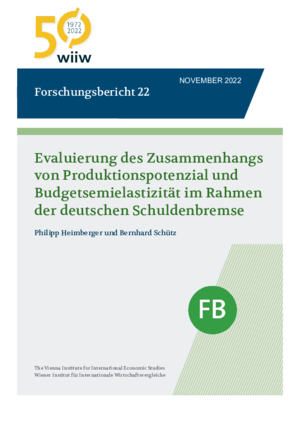Evaluierung des Zusammenhangs von Produktionspotenzial und Budgetsemielastizität im Rahmen der deutschen Schuldenbremse
Philipp Heimberger and Bernhard Schütz
wiiw Research Report in German language No. 22, November 2022
41 pages including 22 Tables and 2 Figures
Evaluierung des Zusammenhangs von Produktionspotenzial und Budgetsemielastizität im Rahmen der deutschen Schuldenbremse
This publication is available in German language only.
For a brief English summary see further below.
Die Konjunkturbereinigung des Budgetsaldos bestimmt im Rahmen der deutschen Schuldenbremse maßgeblich die maximal zulässige Nettokreditaufnahme des Bundes. Die Konjunkturkomponente erfordert eine Schätzung des gesamtwirtschaftlichen Produktionspotenzials in einer konjunkturellen Normallage und der Budgetsemielastizität, wobei letztere die Reaktion der Einnahmen und Ausgaben des Bundes auf eine Änderung in der Produktionslücke misst. Während Modellunsicherheiten und Revisionsanfälligkeiten bei der Schätzung des Produktionspotenzials vielfach dokumentiert sind, bleiben technische Fragen rund um die Budgetsemielastizität bislang vergleichsweise unterbeleuchtet. Im Kontext der Evaluierung der Produktionspotenzialschätzungen im Rahmen der deutschen Schuldenbremse untersucht dieser Beitrag die Sensitivität von Schätzungen der Budgetsemielastizität anhand des relevanten gemeinsamen Ansatzes der Organisation für wirtschaftliche Zusammenarbeit und Entwicklung (OECD) und der Europäischen Kommission, wenn unterschiedliche Schätzungen des Produktionspotenzials (von OECD, Bundesministerium für Wirtschaft und Klimaschutz, Europäischer Kommission und Dezernat Zukunft) herangezogen werden. Die Ergebnisse verweisen darauf, dass unterschiedliche Dateninputs bezüglich des Produktionspotenzials und seiner einzelnen Bestimmungsfaktoren (insbesondere der non-accelerating wage inflation rate of unemployment, kurz: NAWRU) erheblichen Einfluss auf die Basis-Elastizitäten von Einnahmen- und Ausgabenkategorien hinsichtlich einer Änderung der gesamtwirtschaftlichen Aktivität haben können. Dies führt zu Abweichungen in der Budgetsemielastizität: Während die offizielle Punktschätzung bei 0,203 liegt, ist das Minimum unserer Sensitivitätsanalyse bei 0,120 und das Maximum bei 0,241. Die daraus resultierenden Abweichungen in der Schätzung der Konjunkturkomponente beeinflussen die Bestimmung der maximal zulässigen Nettokreditaufnahme des Bundes.
Evaluation of the Relationship between Potential Output and the Budget Semi-Elasticity in the Context of the German Debt Brake
The cyclical adjustment of the budget balance largely determines the maximum permissible net borrowing of the federal government within the framework of the German debt brake. The cyclical component requires an estimate of aggregate potential output in a normal cyclical situation, as well as an estimate of the budget semi-elasticity, the latter measuring the reaction of federal government revenues and expenditures to a change in the output gap. While model uncertainties and revisions in the estimation of potential output have been widely documented, technical issues surrounding the budget semi-elasticity remain comparatively understudied. In the context of the evaluation of potential output estimates used as part of the German debt brake, this paper examines the sensitivity of estimates of the budget semi-elasticity using the relevant joint approach of the Organisation for Economic Co-operation and Development (OECD) and the European Commission. When we use different estimates of potential output (from the OECD, the Federal Ministry for Economic Affairs and Climate Protection, the European Commission and Dezernat Zukunft) and its components (especially the non-accelerating wage inflation rate of unemployment, NAWRU for short), the results indicate that different data inputs can have a significant impact on the basic elasticities of revenue and expenditure categories with regard to a change in aggregate activity. This leads to deviations in the budget semi-elasticity: while the official point estimate is 0.203, the minimum of our sensitivity analysis is 0.120 and the maximum is 0.241. The resulting deviations in the estimate of the cyclical component influence the determination of the maximum permissible net borrowing of the federal government.
Keywords: Staatsschulden, Schuldenbremse, Fiskalpolitik, Budgetelastizität, Einnahmen, Ausgaben
JEL classification: C54, E62, H60
Countries covered: Germany
Research Areas: Macroeconomic Analysis and Policy
